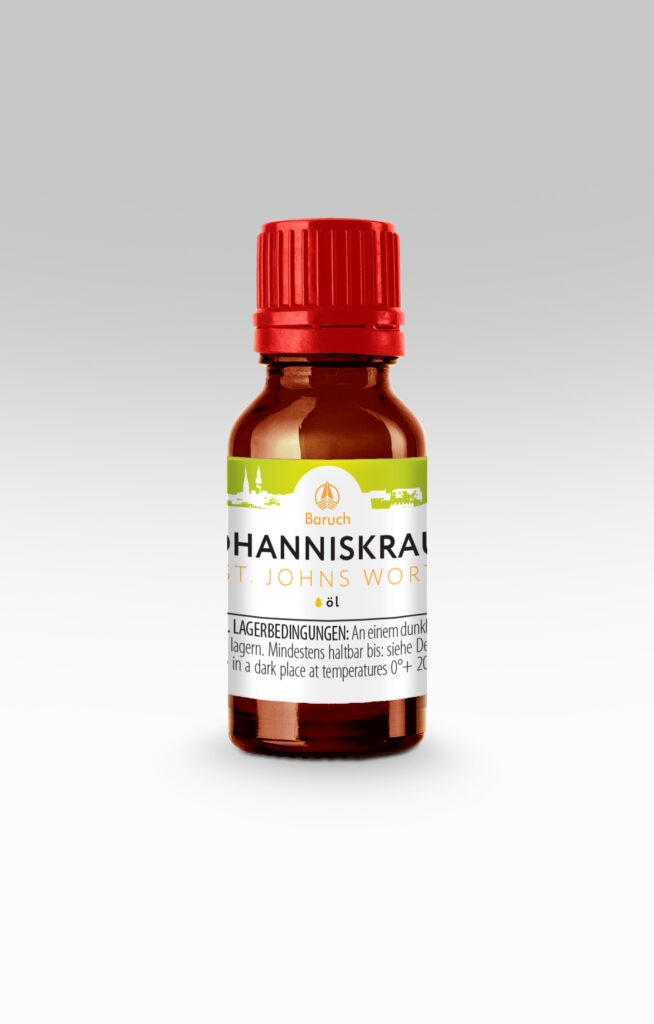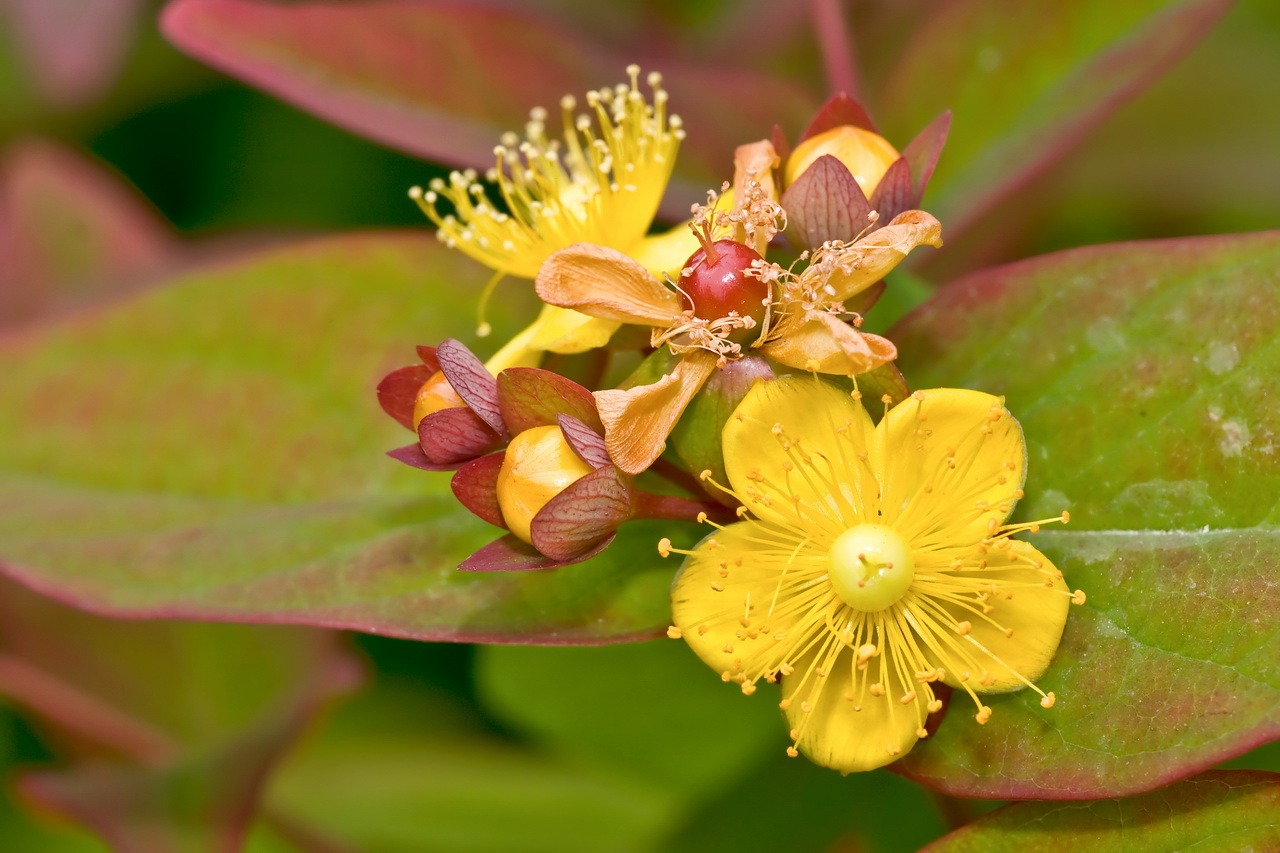Hypericum perforatum, known as perforate St John’s-wort, is a flowering plant in the family Hypericaceae and the type species of the genus Hypericum. St. John’s wort is one of the most famous and widely used medicinal plants, and the top part of the stem with St. John’s wort flowers is also used in the formulation of a number of foods.
The CO2 extract from St. John’s wort is an oily liquid of red-brown color with a distinctive, light St. John’s wort aroma.
Preparations based on St. John’s wort have been included in the State Pharmacopoeia of the Russian Federation, the European Pharmacopoeia and the Pharmacopoeia of the USA and Canada. St. John’s wort extract has a wide range of pharmaceutical properties. It is recommended as an antibacterial, antiseptic, analgesic, wound healing, anti-rheumatic, diuretic, choleretic, astringent, antihelminthic and also regenerative agent. It is traditionally used to treat heart diseases, rheumatism, colds, flu, headaches, diseases of the liver, stomach, bladder, bed-wetting, hemorrhoids, inflammation of the female genital organs. St. John’s wort extract is widely used as an effective, mild antidepressant.
In the production of food, the herbs and flowers of St. John’s wort are used as herbal tea as well as in the preparation of non-alcoholic and alcoholic beverages.
St. John’s wort extract is included in the classic recipes of national Russian balms. St. John’s wort extract is also one of the ingredients in the famous Soviet drink “Baikal”.


Chart 1. The main components of the CO2 extract of St. John’s wort
| NAME | CONTENT IN% OF THE AMOUNT OF VOLATILE COMPONENTS | EFFECT |
|---|---|---|
| α-pinene | 22 | Easily penetrates the epidermis and irritates the nerve endings, which leads to intensive blood circulation. Has an expectorant effect |
| Palmitic acid | 7,5 | Unsaturated fatty acid for water repellency in cosmetics |
| 2-methyloctane | 4,5 | Part of warming ointments |
| Н-Nanocosan | 4,4 | Refers to saturated hydrocarbons, a fat-like compound. It has wound healing and anti-inflammatory properties |
| Phytol | 2,2 | Anti-inflammatory, also for mastopathy |
| Caryophyllene oxide | 1,8 | Used in perfumery. Little is known about its functional properties, it is believed that it is useful in bronchial and urological diseases, in the treatment of poorly healing wounds and skin diseases |
| β-caryophyllene | 1,6 | Is used in perfume compositions, in fragrances for soaps and cosmetics. Reduces anxiety and stress |
| 2-methyldecane | 1,5 | Part of warming ointments |
| N-Udekan | 1,2 | Is a component of moisturizing cosmetics |
More than 50 general compounds were found in the CO2 extract of St. John’s wort using chromatomass spectrometry.
In cosmetics, preparations based on St. John’s wort extracts are rightly used widely. However, more often hydrophilic extracts are used, which have a relatively low cosmeceutical activity.
The CO2 extract from St. John’s wort enables the manufacture of cosmetics with the following properties:
- Creams for problematic and acne-prone combination skin
- Cream to normalize the skin’s water-fat balance
- Products for sensitive, irritated, inflamed, allergy-prone skin
- Creams for mature skin with antioxidant, rejuvenating properties
- Wound healing and anti-burn creams
- Means for smoothing scars
- Baby creams for the prevention of dermatoses and allergic dermatitis
- Cream for a quick tan
In food production, the CO2 extract from St. John’s wort in the form of a microemulsion is mainly used for the production of soft drinks and alcohol-containing balms and infusions.
Chart 2. Application rates, recommendations for the use and storage of St. John’s Wort CO2 extract
| Food usage rates | Item А100: 0.002% (20g per ton) Water-soluble microemulsions EMA1: 0.1% (1l per 1000l or 1ml per liter) |
| Application rates in cosmetics | Item А10: 1-3% Item А100: 0.1-0.3% |
| Recommendations for use | It is recommended to add CO2 extracts in the final stages of preparation, in the cooling phase of the end product. |
| Storage Instructions | It is recommended to store CO2 extracts in a closed container in a cool room and avoid direct sunlight. |
| Use in dietary supplements | Application in cooking | Application in cosmetics |
| In official medicine, black currant leaves are recommended as a diuretic, disinfectant and diaphoretic. CO2 extract can be recommended for use in urolithiasis, pyelonephritis, cystitis. In folk medicine, various extracts and infusions of black currant leaves, including in oil, which is a close analogue of CO2 extract, were used to normalize the functioning of the cardiovascular system, strengthen the walls of blood vessels, Cleanse blood of toxins and normalize blood pressure. Such extracts have a beneficial effect on the functioning of the liver and kidneys. The extract helps boost immunity and helps fight colds and viral infections. | It can be recommended for use in the manufacture of alcoholic and non-alcoholic beverages and various confectionery products. It should be noted that the aroma of CO2 extract from black currant leaves has the unique property of completely crowding out odors generated by synthetic aromas from products. A synthetic analogue and fakes with a similar taste do not have this property. | It is used as part of creams – for skin rejuvenation, moisturizing and removing irritation, creams to combat fine wrinkles, stretch marks and scars, including postoperative scars, creams and tonics for skin care around the eyes, dark circles, increasing elasticity; – in nail care creams, to strengthen and care for the nail plates, heal small cracks and wounds around the nail; – foot care creams with deodorizing action and softening of calluses and corns; – creams for quick tanning without risk of sunburn; – Masks to combat skin irritation and itching on the head, anti-dandruff. The extract regenerates the skin of the hands and fights age-related pigmentation. |
Historical facts
In Christianity, it is believed that St. John’s wort appeared in place of drops of blood from John the Baptist that fell to the ground when his head was cut off. Hence there is a popular name for St. John’s wort – “Ivansgras” and many other popular names are associated with the mention of blood.
In Europe and Russia, the herb St. John’s wort was considered a magic plant. Girls used it for love spells, travelers thought it was an amulet against robbers and wild animals. In everyday life, the hostess always kept St. John’s wort brooms in the house to scare away evil spirits and witches. It was believed that St. John’s wort gave children good dreams.
